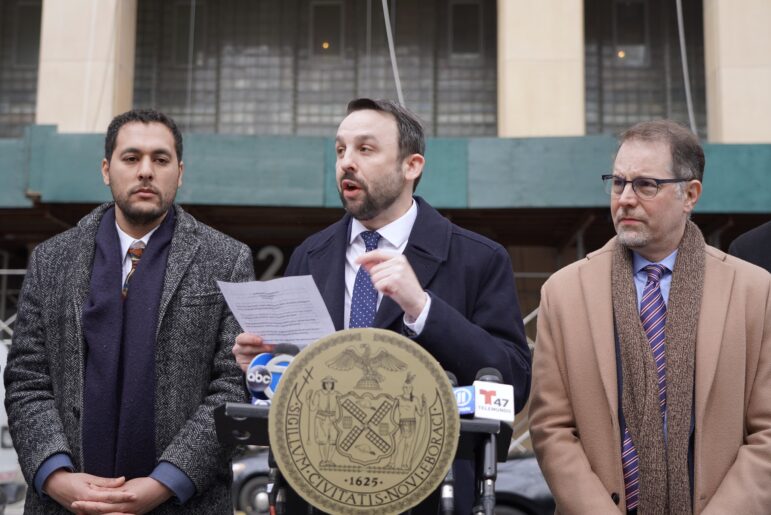If the 4 percent rate had been fixed, the same set of affordable housing projects that lost $51 million in equity this year would have raised $240 million instead, helping to finance 1,700 affordable units in New York City.

Adi Talwar
Construction work at an HPD site located at 263-267 West 126th Street.New York City’s housing crisis is reaching a breaking point as the economic shock from the pandemic exacerbates a long-standing housing shortage. Meaningfully addressing this crisis requires us to use every tool at our disposal to create more affordable housing. Unfortunately, a flaw in the Low-Income Housing Tax Credit (LIHTC) program, the primary funding mechanism for affordable housing construction in New York and across the nation, makes it more expensive to build during economic downturns – right when it is needed most.
A simple Congressional tweak can make a huge difference: setting a minimum 4 percent rate for LIHTC would create nearly 23,000 additional units of affordable housing over the next decade in New York alone. Congress can make that change right now as it debates a package of bills for the 2020 fiscal year. It must do so immediately.
We cannot afford a delay: rural and urban communities across the country are in a housing emergency and desperately need more affordable housing. Fixing LIHTC will materially improve lives from coast-to-coast.
The issue is particularly acute in New York. Before the pandemic, more than one million New York City households were rent-burdened and on average nearly 60,000 people spent their nights in a municipal shelter. Now, with an unemployment rate higher than 13 percent, hundreds of thousands of already low-income New Yorkers have less money to pay rents that were already too high. While an eviction moratorium has been in place since March, tens of thousands of households are at immediate risk of eviction once it is lifted come the new year.
LIHTC is a part of the solution. The 4 percent credit alone, the most commonly used component of the LIHTC program, funds nearly 75 percent of all affordable units in New York. It has helped get more than 114,000 affordable homes built, served nearly 300,000 low-income households, and created more than 100,000 local jobs since its 1986 inception.
But we can do even more.
The 4 percent credit works because it allows a property owner to claim a tax worth about 30 percent of the development costs on an affordable building. But that 4 percent rate is a “floating” rate, meaning it is tied to Treasury Department interest rates. In other words, it does not always mean 4 percent – and, in times of downturn, it becomes even less valuable as a result of the federal government stimulating investment by lowering interest rates. This has an unintended consequence: it reduces equity in affordable housing.
 CityViews are readers’ opinions, not those of City Limits. Add your voice today!
CityViews are readers’ opinions, not those of City Limits. Add your voice today!
This year, the LIHTC 4 percent credit value hit a historic low of 3.07 percent, which reduced affordable housing equity in New York alone by $51 million equity loss year-over-year. This complication compounds a $500 million budget cut to the Department of Housing Preservation and Development (HPD) by creating budget gaps in projects, stalling New York City’s pipeline of affordable housing.
Setting a minimum floor of 4 percent would ensure the credit stays valuable even during down times. For example, if the 4 percent rate had been fixed this year, the same set of affordable housing projects that lost $51 million in equity would have raised $240 million instead, helping to finance 1,700 affordable units in New York City.
A floating rate prevents affordable housing investment from being the countercyclical tool that it should be in a down market. Now is the time to invest in affordable housing when borrowing rates are low and the real estate market is softening, presenting opportunities such as distressed hotels that could be turned into affordable housing. And it would help get projects currently delayed by funding gaps back on track by creating up to 25 percent more equity.
In other words, this simple change would serve as precisely the economic stimulant New York needs right now. Better yet, it is a bipartisan fix that would address a nationwide crisis. It is an opportunity too good to let pass us by.
Rachel Fee is the executive director of the New York Housing Conference.









One thought on “Opinion: To Make New York More Affordable, Fix the Low-Income Housing Tax Credit”
What about developers that claim affordable housing but do not provide any perks they promise to the neighborhood they are building in. There’s no agency cross checking so they are probably doing this to all their Properties. For instance Larkspur on West 117th Street in Harlem. The landlord agreed to build a school with Sleeping Accommodations but instead built a 2nd residential building. Or promise to build outdoor recreation spaces but never did and gets away with it. Affordable Housing with oversight where it counts, that’s what’s needed.